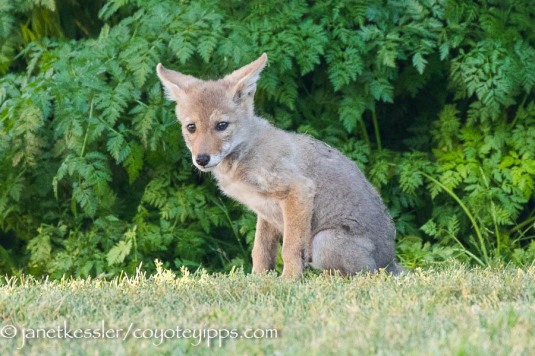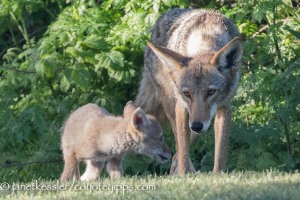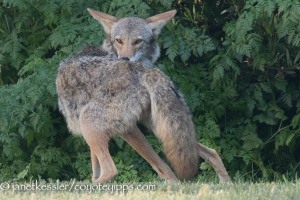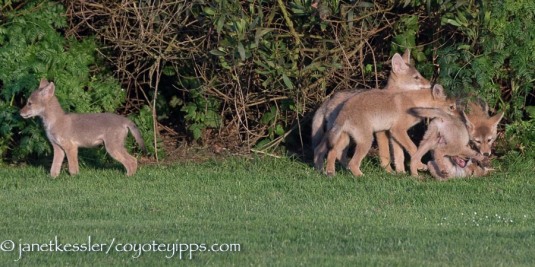I’ve put together some information on coyote pups based predominantly on my own observations. Other information is included, including some hearsay, which I’ve stated as such. Push the underlined links I’ve provided for even more information.
Coyote pups are about two months old now here in San Francisco.
Etiquette: Please stay away from any place where you even suspect a den might be, and please especially keep your dogs away from those areas. Besides cars, dogs are coyotes’ biggest threat in urban areas. You can prevent stress and trauma to yourself, your dog, and coyote parents with new pups by leashing your dogs if you must move through such an area. Word-of-mouth from other park visitors about a den’s general whereabouts should be enough for you to voluntarily avoid those areas.
Terminology: Baby coyotes are referred to as “pups” (not cubs)!
Dates of birth: In San Francisco, pups are normally born towards the beginning of April after a gestation of 63 days. Coyotes come into heat just once a year (as opposed to dogs’ twice a year cycle) — they can only produce one litter a year which is usually born sometime in the Springtime. The courting behavior which leads to pups can be observed at the end of January.
Litter Sizes: A “litter” is the group of pups that are born and raised together in one family. Some yearlings from the previous year’s litter or before — those that didn’t disperse (leave) — may remain in the family and may even help out a little by bringing in food for the youngsters. I have seen anywhere from one to seven pups born in one litter in San Francisco: that’s quite a spread! I have heard of larger litters, as many as 11 to 19 (not in San Francisco), but I’ve also heard (but not seen) that this very large litter size may actually be the result of “den sharing”: two females sharing the same den.
From my own observations, I’ve seen litters vary in size over several consecutive years from the same parents as follows: Maeve and Toughy 1-2; Ma’am and Monte 2-5-1; Cai and Yote 7-2-? (haven’t had a chance to count this year’s yet); Maya and Ivan (3-4-5); Chert and Silver 1-0-0-0-4;. These are all variations of normal litter sizes. The exception was the five litters where there were sometimes no survivals: this anomaly was almost certainly related to inbreeding in this family; Chert went through the motions of having pups during those three years of no pups, but none ever appeared. Besides these normal, small fluctuations, the litter sizes I’ve seen in San Francisco have not changed over the 12 years that I’ve been studying coyotes, even though the coyote population here has grown from an initial 8 in 2002 to several score and appears to be at its saturation point, as revealed by more and more brutal territorial battles that have displaced resident coyotes.
So although I’ve heard it speculated that coyotes “regulate” their litter size: I’ve not seen an indication of this here in San Francisco. They appear to just ‘get what they get’ — like the rest of us (those who don’t take hormones). And rather than the proviso that “locations dictate litter size”, I would think that litter size might have a genetic component. I know that natural multiple births seem to run in human families, so might litter size also have a genetic component?
Newborn pup size: Coyote pups at birth weigh between 1/2 and 1 pound. This has been measured by wildlife rehabilitation facilities which take in these newborns. Weight can vary substantially between the pups in one family which may include some “runts”. Their personalities also develop differently. Some, right from the start are adventuresome and exploratory: they are curious about everything and wander far, rather brazenly. Others have more of a built-in wariness and fear: they are on-edge and more anxious and keep closer to home. Some are more interactive and social, involved in a lot of rough-house playing and teasing, while others are more withdrawn, preferring to sit back and watch the others. Each of these has it’s benefits for survival: one is not necessarily a “better” personality type than another.
Dens and birthing: Coyote pups are born in dens which were either dug for this purpose by their parents or they were pre-existing “homes” of other animals, such as raccoons or skunks, that were broadened and enlarged by the to-be coyote parents for their purposes. A den can also be an existing hole in the ground, cavities under tree trunks, a depression with good covering, or a nook under a ledge. I have only seen dens long after they were abandoned, I have never seen an occupied den: I keep my distance from these.
Coyote dens are used only for a short time: for birthing and nursing during the very early life of pups and for the few months thereafter. Dens are outgrown, just as are birds’ nests or human cradles, after which the youngsters sleep in protected or hidden areas as do the parents. At around six weeks of age pups begin venturing beyond the den, but they’ll stick close to the den for much longer than that.
Here is a video of a wolf giving birth: I think we can assume that it must be pretty similar to what a coyote goes through. They emit howls as they give birth, and you hear a little of that here:
Do mothers stay in the dens for an extended period of time after giving birth? Well, if some do [this video shows pups right after, and pups’ first howls], it’s not a hard-and-fast behavior practice: I’ve seen one mother out within a day of giving birth and I’ve seen others out in far less than a week.
Coyote pups may be left all alone for extended periods of time while the parents go off hunting. So, please don’t “save” what you think are “abandoned” pups — parents are likely simply off hunting. NO ONE can raise coyote pups as well as their own parents. You are actually hurting their chances for survival if you take their welfare into your own hands. If you truly believe they’ve been abandoned, then monitor them for several days before taking them to a wildlife center.
Nourishment: Coyote pups live on their mother’s milk alone for the first few weeks. This diet is soon supplemented with regurgitated food at about one month of age. The regurgitated food consists of whatever the parents consume, mostly rodents, but also fruit, amphibians, insects, birds and even garbage. How long do the youngsters lactate? I’ve seen mothers’ tit size shrink by the end of May, so I assume by that time the youngsters are well accustomed to semi-solid diets and on their way to whole prey soon. First, dead prey is brought to the youngsters, after which the pups are taken out to practice hunting on their own. Interestingly, I’ve seen coyotes over one year of age still being brought regurgitated food from a father: the youngsters approach Dad from below his chin, wedging their muzzles under his upper lip. This causes the regurgitation response. Dad then expels the food onto the ground, and the youngsters grab and eat it.
As the youngsters grow, Dad continues his contributions in the food department by bringing home prey to help feed the youngsters. Both coyote parents, unusually, raise the youngsters and you may find Dad at times sitting out and “minding” the offspring, giving Mom a break.
An interesting observation I’ve made is what I call “facilitating.” When the pups are learning to hunt, a mother will kill a rodent and bury it where the pups can easily find it!
Survival rate: Survival rate of pups is known to be low — 20-30% is what the literature says, but what I’ve seen in San Francisco is closer to about 70% from the time the pups can first be seen. However, it should be noted that I myself never know how many pups were actually born because I never intrude into their den areas: I wait to see what a litter is like until Mom brings them out or they are spotted through the bushes. Between birth and when I see them, there could have been more pups who didn’t make it.
First appearances: You might glimpse youngsters now, at two months of age, through the bushes, but it won’t be because coyotes want you to. Youngsters are highly protected as they grow up. And if a youngster sees you, he/she is bound to head straight to the bushes to hide! And parents are bound to come out to warn you to stay far, far away!
Family howl session in response to sirens. The howling family consists of Mom and Dad and four two-month old pups! Note that, although coyotes keep youngsters hidden as much as possible, they seem to have no qualms about being heard!
Here is what coyotes look like during their first year of growth:
- First month of life
- Two months old (siblings of different sizes)
- Three months old
- Five months (with Dad)
- Six months with Dad
- 7 months old
- 9 months
- 14 month old siblings
Coyotes may leave home (dispersal) anytime after they are about 9 months of age, which is about January in SF. The earliest I’ve seen was a female who left home at 9 months of age. And the latest I’ve seen was a male who didn’t leave until he was 2.5 years of age, even though his father attempted pushing him out almost a year beforehand. The Presidio has tracked some of these dispersals to 60 miles south of the city, and I’ve been able to track some to vacated niches within the city itself. Many dispersing youngsters get killed by cars during this treacherous dispersal time in their lives. They also come across extremely hostile territorial coyotes who make it clear that they are not one bit welcome.






































 The runt in a litter, when there is one, is the smallest and sometimes the weakest pup. Their biggest disadvantage is that, because all the other pups are larger than them, they have a harder time competing for Mom’s milk. It turns out that getting one’s fair share of milk during the first 48 hours after birth is very important: only that very initial supply of milk contains colostrum which is loaded with antibodies which primes the pups’ immune systems, without which they could be more vulnerable to illnesses.
The runt in a litter, when there is one, is the smallest and sometimes the weakest pup. Their biggest disadvantage is that, because all the other pups are larger than them, they have a harder time competing for Mom’s milk. It turns out that getting one’s fair share of milk during the first 48 hours after birth is very important: only that very initial supply of milk contains colostrum which is loaded with antibodies which primes the pups’ immune systems, without which they could be more vulnerable to illnesses.

















